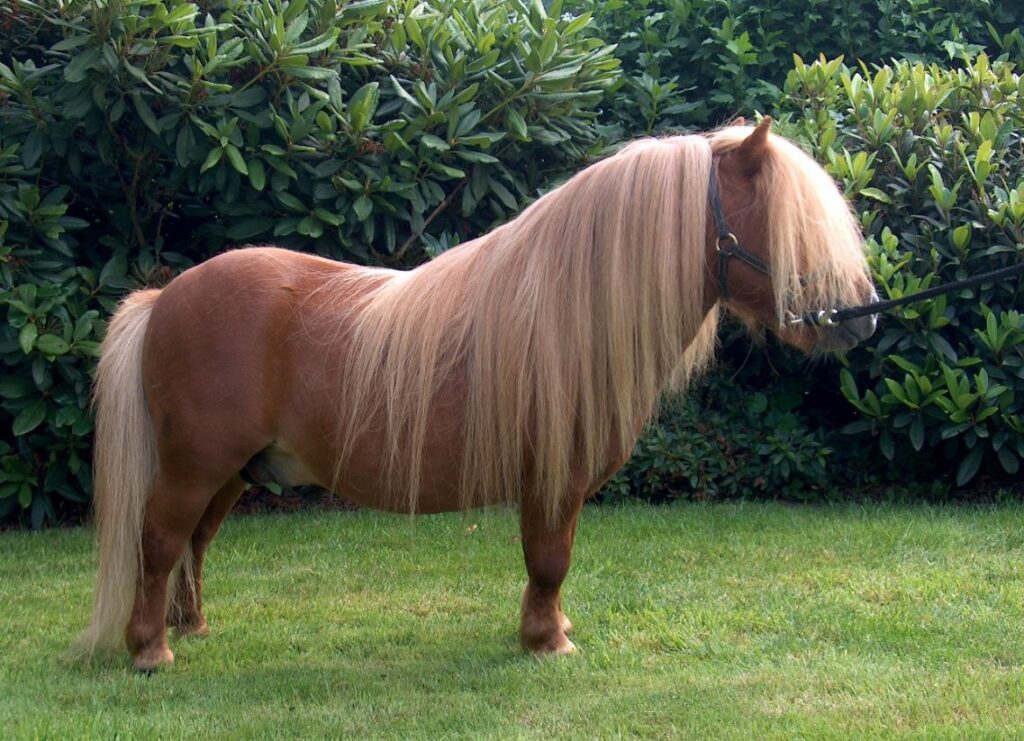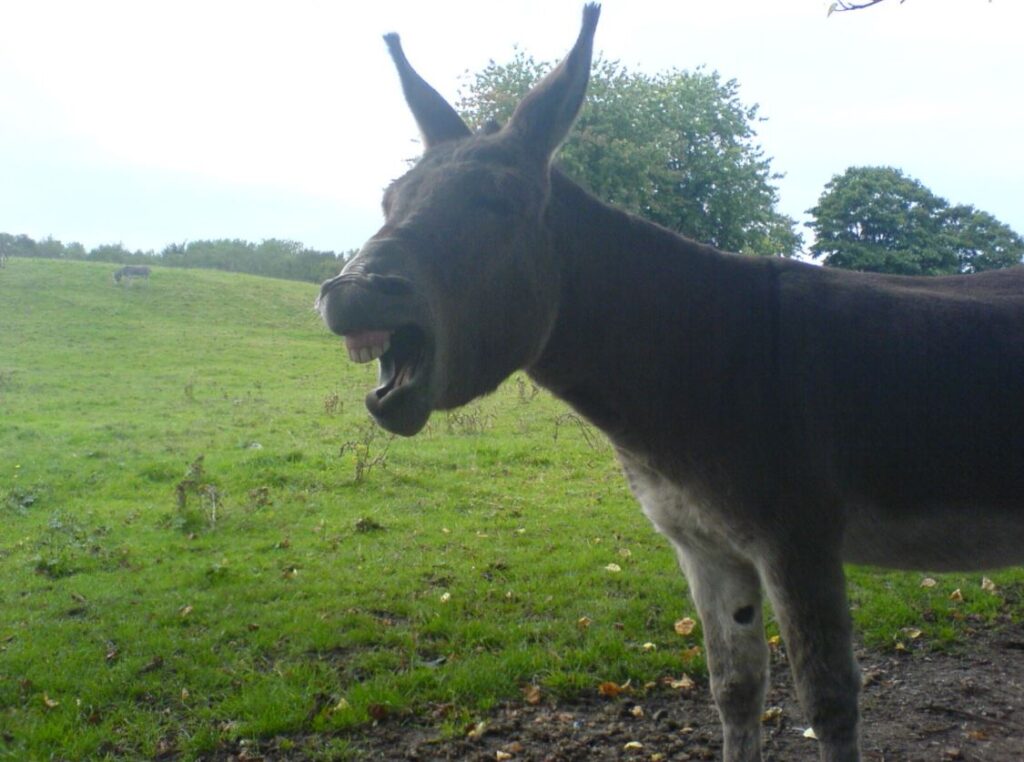At first glance, donkeys and ponies do appear to be quite similar. However, that is not the case as several differences make it easy to tell them apart.
How To Tell Donkeys and Ponies Apart
1. Ears
A donkey’s ears are far bigger than those of a pony and are a pretty distinctive feature. Their ears are so big because donkeys originated in the deserts and the large surface area of their ears helps them cool down by dissipating the heat from their bodies. They also provide them with excellent hearing to hear the call of another donkey from many miles away.
2. Mane and tail
A donkey’s mane is much shorter than a pony’s, and it is stiff and stands up while a pony’s mane, like that of a horse, is much softer and falls over the side of their neck. There are distinctive differences in their tails, too – a pony’s tail begins at the top of its hindquarters and grows long down from its dock, while a donkey’s tail has short hairs down it and then long hairs that grow from the bottom of it, much like a cow’s tail.

3. Sound
A donkey brays while pony neighs, and it is probably the most tell-tale sign of a donkey. The sound of a donkey is a loud, distinctive “hee-haw” that can be heard from far away, while a pony makes a much different sound by “whinnying” or “neighing”. Although they can still be loud, usually when calling others, ponies are much quieter than donkeys and communicate a lot through snorts.
4. Colour
Ponies come in all different colors – from chestnut, grey, black, bay, roan, piebald (black & white), to skewbald (brown & white) – and they can have all manner of white markings on their legs or faces. However, the main color of a donkey is grey, then brown and black, and other colors and markings are much rarer.
5. Hooves
As donkeys were originally desert animals and used to walking for many miles every day, their hooves adapted to their harsh living conditions and are much tougher than those of ponies. A donkey’s hooves are smaller than ponies, and the “angle” of them is much steeper. Also, the frog part of the hoof is much larger and wider than on a pony’s.
6. The cross
Nearly every single donkey in the world has a mysterious cross on its back. This line of darker hair goes from the top of its neck to the top of its tail and a line that goes across the shoulders. Although there are a few ponies that have a dorsal stripe (the line that goes from the neck to the tail), they are mainly only ponies with a dun coat color, and none ever have the line that goes across the shoulders to form the cross the same as a donkey has. It is often thought that the cross is a sign of Jesus.
7. Chestnuts
Chestnuts are a horny growth on all ponies’ legs. They are found on the inside, near the knees on the front legs, and near the hocks on the back legs. However, donkeys do not have chestnuts on their back legs, but they do have them on their front legs.
8. Length of gestation
Female ponies carry their foals for around eleven months before giving birth to them, but female donkeys (jennies) carry theirs for more than a year – around fifty-six weeks, to be exact.
9. Chromosomes
Although it’s not a difference that you can see, ponies have two more chromosomes than donkeys, with 64 chromosomes to a donkey’s 62.
10. Temperament
Again, although it depends on the individual, ponies are often much flightier than donkeys. Donkeys are extremely social animals and form incredible bonds and attachments. They are less likely to react in “flight” mode if they see something scary than a pony is.
11. Vertebrae
Ponies have six lumbar vertebrae, but donkeys only have five.
12. Back
Donkeys have much wider and flatter backs than ponies, making it difficult to put a saddle on.
13. Hardiness
On the whole, donkeys are much harder than ponies and can live on much less food. While ponies are often hardier and need less food than horses, and donkey needs less still. Due to their desert origin, donkeys are not suited to rich pastures as it can lead to several health problems; they are best on a nearly bare paddock and do not have the same nutritional requirements as ponies.
14. Face
Ponies have a much shorter face from top to bottom than donkeys.
Questions & Answers
Question: Are donkeys and ponies the same species?
Answer: No, donkeys and ponies are not the same species. Although they are both of the same genus, Equus, donkeys are Equus Africanus, while horses and ponies are Equus Caballus.
Question: Can donkeys and ponies mate?
Answer: Yes, a donkey and a pony (or horse) can produce a hybrid offspring known as a mule if it is the product of a male donkey and a female pony, or a hinny if it is from a male figure, a male pony and a female donkey. These hybrid offspring are infertile as they are cross-species offspring and so cannot reproduce.
Question: Is a donkey stronger than a pony?
Answer: Yes, donkeys are well known for their strength and versatility and are physically much stronger than ponies. In the past, donkeys have been used to pull huge fallen trees off roads and trails where machinery couldn’t access. They have also long been used for carrying cargo and other goods across desert and mountain terrains.
Question: Are donkeys bigger than ponies?
Answer: Not all the time. For a start, it depends on the breed of the pony in question – some ponies such as Shetlands can be very small, measuring only approximately 30 inches high in some cases – while others can be as big as 14 hands (56 inches). The size of donkeys also varies greatly – their average height is around 12 hands (48 inches), but they can be both bigger and smaller than that.
Question: Why do donkeys bray?
Answer: Donkeys make a loud sound, known as a bray, to communicate with other donkeys. They often use it as a warning system for other herd members if they saw a predator in the wild, such as a wolf or a coyote. Their bray has a double purpose as it warns others and can also be used to scare the predators off.
Question: Why do donkeys have a cross on their back?
Answer: Legend says that all donkeys carry a cross on their back to symbolize Jesus and his cross. It is often thought that the donkey wanted to carry his cross for him, and that is why they are now all marked with the cross on their backs.
Question: Can donkeys and ponies live together?
Answer: Yes, donkeys and ponies can live together quite happily. Donkeys usually have a calming influence on horses and ponies as they settle easier and are less flighty. Donkeys are often used as companions for foals when taken away from their mothers for the first time due to their calm nature.
Question: Are ponies friendlier than donkeys?
Answer: Although it depends on the individual animal, donkeys are often calmer than horses and ponies. Donkeys are very intelligent and emotional animals that form strong bonds.
Question: Which kicks worse – a donkey or a pony?
Answer: While you don’t want to be getting kicked by either of them, generally speaking, the bigger animal will kick the worst, so it depends on what size donkey or pony it is. All animals have a fight or flight response, and while ponies are most definitely flight animals, a donkey is a bit more “fight” as in the wild, they will attack a predator by biting and kicking it. This why donkeys are used as “livestock guardians” by some farmers to prevent their sheep or cows from being attacked by coyotes or mountain lions.
Question: Are ponies faster than donkeys?
Answer: Yes, generally, ponies are faster than donkeys as they have a longer stride.
Question: Can donkeys jump?
Answer: Yes, surprisingly, donkeys can jump just as well as ponies can, and they are quite capable of jumping over a fence to escape.
Question: Can donkeys be ridden?
Answer: Generally speaking, donkeys are too small to be ridden by adults, although children can ride them.
Question: How many different breeds of pony are there?
Answer: There are many different breeds of pony – over one hundred – and there are 350 different breeds between horses and ponies.
Question: Which live longer – donkeys or ponies?
Answer: Most donkeys live longer than ponies. The average age for a pony is 25-30 years, while donkeys have lived for well over forty years.
Question: Why do donkeys curl their top lip?
Answer: Donkey and ponies both curl their top lip when they investigate new smells, and it is called the Flehmen response.

